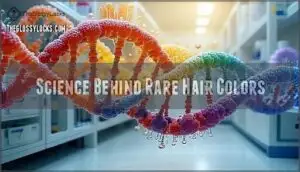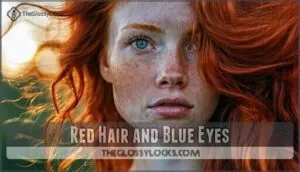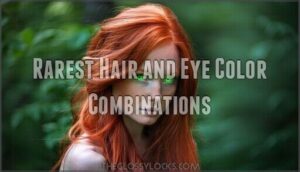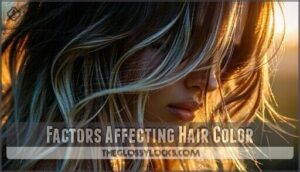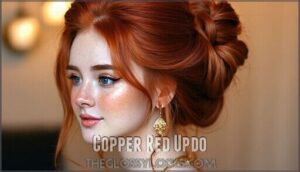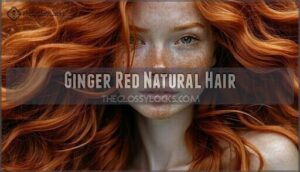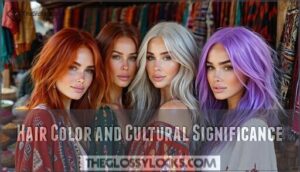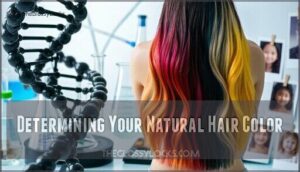This site is supported by our readers. We may earn a commission, at no cost to you, if you purchase through links.

You’ll need two copies of a recessive MC1R gene variant to have red hair, which explains why it’s so uncommon.
Both parents must carry this genetic trait, making redheads rarer than a lucky penny.
Most redheads live in Scotland and Ireland, where up to 13% of people sport this fiery shade.
In contrast, countries like Japan have virtually no natural redheads, and the genetics behind hair color reveals fascinating patterns of inheritance and distribution that paint a colorful picture of human diversity.
Table Of Contents
- Key Takeaways
- Hair Color Distribution Across The Globe
- What is The Rarest Hair Color in The World?
- Science Behind Rare Hair Colors
- Rare Hair Color Combinations
- Hair Color Genetics and Inheritance
- Rarest Hair and Eye Color Combinations
- Factors Affecting Hair Color
- Rare Hair Color Examples
- Hair Color and Cultural Significance
- Determining Your Natural Hair Color
- Frequently Asked Questions (FAQs)
- Why are some hair colors rare?
- What is the least common hair color?
- Is red hair rare?
- What is the most common hair color in the world?
- Which hair color is the rarest?
- What is the rarest hair color with blue eyes?
- What are the top 3 rarest hair colors?
- What is the rarest skin color?
- Which hair color is the least common?
- What is the 1st rarest hair color?
- Conclusion
Key Takeaways
- You’ll discover red hair is the rarest natural color globally, appearing in just 1-2% of people worldwide due to recessive MC1R gene mutations that both parents must carry.
- Your chances of having red hair and blue eyes drop to an incredibly rare 0.17% of humanity, making this the most uncommon hair-eye combination you’ll encounter.
- You’re most likely to find natural redheads in Scotland (13%) and Ireland (10-15%), where Celtic genetics create the highest concentrations of this fiery trait.
- You’ll need two copies of the recessive MC1R gene variant to express red hair, which explains why it’s dramatically rarer than dominant traits like black hair that affects 75-85% of the global population.
Hair Color Distribution Across The Globe
You’ve probably noticed hair colors vary dramatically around the world, but the actual numbers behind this diversity tell a fascinating story about human genetics.
Understanding global hair color distribution reveals which shades are truly common and which ones make you part of an incredibly rare group, and this understanding is key to appreciating the diversity of human hair colors.
Black Hair Prevalence
Black hair dominates the global population like no other shade, affecting roughly 75-85% of people worldwide.
This dark hair prevalence stems from exceptionally high eumelanin levels that create those signature deep tones you’ll recognize across continents.
Global distribution patterns reveal fascinating insights about this common trait:
- Asian populations show nearly universal black hair prevalence, especially in China and India
- African nations display varied textures while maintaining consistent dark coloration
- Genetic factors create thickness variations, with East Asian hair showing remarkable uniformity
- Hair texture differences reflect ancestral origins and environmental adaptations
- Cultural significance varies dramatically across regions, from spiritual meanings to beauty standards
The science behind black hair involves complex melanin production that’s been shaped by thousands of years of evolution.
Ancient Egyptians, for example, used lead-based dyes to darken their hair.
Understanding hair color distribution helps explain why this shade connects billions of people across diverse cultures and continents.
Brown Hair Prevalence
Second to black’s dominance, brown hair prevalence encompasses approximately 11-20% of the global population, making it humanity’s runner-up shade.
You’ll discover this versatile color spans incredible shade diversity, from light chestnut to rich chocolate tones across continents.
Brown hair genetics reveal fascinating patterns—dominant traits that spread through European, American, and Australian populations with remarkable consistency.
Global variations show Spain leading at 57%, while countries like Germany and France showcase substantial brown-haired demographics.
Hair color statistics demonstrate brown’s widespread appeal, with cultural perceptions often viewing it as the "standard" phenotype.
Unlike rare colors, brown represents normalcy in many societies, yet its brown hair trends continue evolving through natural genetic variation and global hair colors distribution patterns across diverse ethnic groups.
Two brown-haired parents can still have children with blond hair due to recessive blond alleles.
Blonde Hair Prevalence
Natural blonde hair catches sunlight like golden silk, yet this stunning trait appears in only 2% of people worldwide.
Your blonde genetics represent a rare biological lottery, with blonde shades ranging from platinum to honey tones.
Regional variations show fascinating patterns across populations:
- Finland leads globally – 80% of native population carries blond gene
- Northern Europe dominates – Baltic regions show highest concentrations
- Natural blonde shades outnumber artificial blonding attempts substantially
- Cultural perceptions vary – some societies prize blonde hair rarity more
- Genetic inheritance requires specific combinations from both parents
This blonde hair rarity makes you part of an exclusive genetic club spanning continents.
Red Hair Prevalence
Surprisingly, red hair claims the title as Earth’s rarest natural hair color, affecting only 1-2% of the global population.
This recessive genetic trait results from genetic mutations in the MC1R gene, creating unique ginger hair facts like increased sun sensitivity and higher anesthesia needs.
Natural redheads face diverse cultural perceptions worldwide, making their global distribution particularly fascinating for scientists studying human genetics.
Red Hair Percentage
What is The Rarest Hair Color in The World?
You might think blonde hair is the rarest, but science tells a different story.
Red hair actually claims the crown as the world’s most uncommon natural color, appearing in just 1-2% of the global population, which is a rarest natural occurrence.
Red Hair Rarity
Fiery locks hold the crown as the world’s rarest natural hair color, gracing merely 1-2% of the global population.
Red hair reigns as nature’s most exclusive genetic masterpiece – rarer than finding a four-leaf clover.
This striking rarity stems from mutations in the MC1R gene, which both parents must carry for their children to inherit red hair genetics.
Here’s what makes natural redheads truly exceptional:
- Geographic hotspots: Scotland leads with 13% prevalence, followed by Ireland at 10%
- Sun sensitivity: Higher UV vulnerability due to reduced melanin protection
- Cultural impact: From ancient Celtic warriors to modern ginger hair facts and folklore
- Redhead stereotypes: Fiery temperaments persist despite lacking scientific basis
This genetic lottery creates nature’s most coveted hair color statistics.
Blonde Hair Rarity
You’ll find only 2% of people worldwide sport naturally blond hair, making it remarkably uncommon.
Blonde genetics require recessive genes from both parents, creating stunning shade prevalence variations.
Regional variations show Scandinavian countries hitting 80% prevalence, while most regions barely reach 1%.
Despite blonde stereotypes in media, artificial blondes far outnumber natural ones.
Hair color statistics reveal this rarest hair color category holds surprising hair color distribution patterns globally.
Gray Hair Rarity
While blonde hair captures attention, gray hair presents an even more intriguing case of hair color rarity.
You might think it’s common since everyone eventually grays, but premature graying tells a different story about genetics influence and pigment loss.
Here’s what makes gray hair fascinating:
- Graying Timeline: Most people start graying in their 40s-50s
- Premature Graying: Only 1% under 40 have mostly gray hair
- Silver Shades: Complete gray transformation remains rare before age 60
- Gray Haircare: Environmental factors like stress accelerate the process
The rarest hair color isn’t just about birth – it’s about when pigment loss occurs and how your body responds to aging.
Science Behind Rare Hair Colors
You’ve probably wondered why your friend’s copper hair catches light differently than your brunette locks.
The secret lies in your DNA and two key pigments called eumelanin and pheomelanin, which work together like nature’s paint palette to create every hair shade from platinum blonde to jet black.
Genetics of Hair Color
Understanding hair color genetics means diving into your cellular blueprint.
The MC1R gene controls eumelanin production, while the TYR gene regulates both pigment types.
Genetic mutations in these hair pigmentation genes create the rarest hair color – red hair.
Your genetic hair traits result from complex interactions between pheomelanin levels and these key genes, making red hair genetics particularly fascinating to scientists studying inheritance patterns.
Melanin and Hair Color
Your hair’s color-palette depends entirely on melanin production—nature’s built-in paint mixer that creates every shade imaginable.
This remarkable pigment system controls color intensity through precise genetic control mechanisms, determining whether you’ll have the rarest hair color variations or more common tones.
Melanin types work like specialized artists, with each type contributing different hues to your unique hair pigmentation genes.
The fascinating interplay between eumelanin production and pheomelanin impact creates your hair’s distinctive appearance, while unique hair pigments emerge from complex hair color genetics that make each person’s shade truly one-of-a-kind.
Eumelanin and Pheomelanin
Two key pigments determine your hair’s natural shade through melanin production.
Eumelanin creates brown and black tones, while pheomelanin adds red and yellow hues.
Genetic control of these pigment ratios produces the entire color spectrum – from common brunettes to the rarest hair color, red hair.
When pheomelanin dominates over eumelanin, you get those striking copper locks that provided an evolutionary advantage in certain climates.
Rare Hair Color Combinations
When you combine rare hair colors with specific eye colors, you’re looking at some of nature’s most uncommon genetic combinations.
Red hair paired with blue eyes occurs in less than 1% of the global population, making it one of the rarest combinations you’ll encounter, with nature’s most uncommon genetic traits.
Red Hair and Blue Eyes
When you win the genetic lottery with red hair and blue eyes, you’re among just 0.17% of humanity.
This stunning combination requires inheriting recessive genetic traits from both parents—specifically mutations in the MC1R gene for red hair and HERC2 gene for blue eyes.
People with Celtic ancestry often carry these variants, creating this breathtaking rarity.
Key characteristics of this combination include:
- Increased UV sensitivity due to reduced melanin production
- Enhanced vitamin D synthesis capabilities in low-light environments
- Striking aesthetic perception that turns heads worldwide
This red hair genetics masterpiece represents nature’s most exclusive club among rare hair colors.
Blonde Hair and Blue Eyes
You’ve probably noticed how certain hair color combinations seem almost mythical in their rarity. Blonde hair and blue eyes represent one of nature’s most striking genetic traits, affecting only about 2% of the global population.
This enchanting combination results from recessive gene mutations that reduce eumelanin production. The Genetic Linkage between these traits occurs because the controlling genes sit close together on chromosomes, making their inheritance more likely together than separately.
Here’s what makes this pairing so remarkable:
- Only 9.3% of Americans possess both traits simultaneously
- Finnish populations show 80% blonde hair with 89% blue eyes
- The combination likely provided Evolutionary Advantage in northern climates
- Cultural Impact has made it a beauty standard in Western societies
- Psychological Perceptions often associate this look with purity and attractiveness
The Aesthetic Appeal of this rare hair color combinations stems from the striking contrast and genetic rarity that makes heads turn.
Black Hair and Blue Eyes
You’re looking at nature’s rarest masterpiece when black hair meets blue eyes. This stunning combination affects just 0.2% of people worldwide—that’s roughly 1 in 500 odds!
Melanin production creates this paradox: dominant genes produce black hair while recessive mutations limit iris pigment. Population studies reveal genetic linkage rarely pairs these traits naturally.
Rarity factors include negative genetic correlation between dark hair and light eyes. The aesthetic appeal of this rare pairing has captivated cultures globally, making these genetic traits among the most coveted rare hair traits.
Trait
Prevalence
Black Hair
Blue Eyes
Combined 0.2% globally
Hair Color Genetics and Inheritance
Your hair color isn’t just a roll of the genetic dice—it’s the result of complex inheritance patterns that scientists are still unraveling.
Understanding how dominant and recessive traits work together can explain why you might’ve red hair when neither parent does, or why your blonde locks came as a surprise to your brown-haired family.
Dominant and Recessive Traits
Your hair color story starts with a genetic coin flip between dominant and recessive traits. Dominant genetic traits like dark hair colors steamroll over their quieter counterparts, while recessive genes need perfect partnerships to shine.
The MC1R Gene controls Eumelanin Production, determining whether you’ll sport rich brunette locks or something rarer.
Here’s what makes color inheritance so fascinating:
- Red Hair Inheritance requires two recessive copies—both parents must carry the gene
- Blonde Hair Genetics involves multiple genes working together in harmony
- Pheomelanin Levels increase when MC1R mutations occur, creating fiery reds
- Dark hair dominates because one copy overpowers recessive alternatives
- Genetic traits combine unpredictably, explaining why siblings often have different shades
Understanding these inheritance patterns reveals why certain combinations remain beautifully uncommon.
Inheritance Patterns
Understanding inheritance patterns starts with recognizing how your parents’ genetic traits combine to determine your hair color.
The MC1R gene and TYR gene control eumelanin control, with recessive genes requiring contributions from both parents to express rare colors like red hair.
Dominant and recessive genes interact through complex inheritance patterns, where parental influence creates a genetic blueprint.
Your parental contribution acts like mixing paint colors—sometimes producing unexpected results when recessive gene combinations reveal nature’s rarest shades.
Genetic factors also play a significant role, influencing hair density and thickness.
Genetic Variation
Your genetic makeup creates a fascinating lottery where MC1R mutations and TYR gene variations can produce stunning surprises.
Genetic variation means you might carry recessive genes for rare colors without showing them.
Hair color genetics involves complex interactions between eumelanin levels and pheomelanin ratio, creating unexpected combinations.
Genetic traits hide in your DNA like buried treasure, waiting for the right partner to reveal hair color mutations in future generations.
Rarest Hair and Eye Color Combinations
You’ll be amazed to discover that certain hair and eye color combinations are so rare they occur in less than 1% of the global population.
The rarest combinations involve red hair paired with green eyes and blonde hair with amber eyes, creating genetic masterpieces that science can barely explain.
Red Hair and Green Eyes
When you consider that less than 1% of the world’s population carries both red hair and green eyes, you’re looking at one of nature’s rarest combinations.
This striking pairing requires winning the genetic lottery twice, as both traits stem from recessive genes that must be inherited from both parents.
The genetic link between these traits runs deep in Celtic ancestry, particularly concentrated in Ireland and Scotland.
While red hair affects only 1-2% globally and green eyes appear in about 2% of people, their combined occurrence creates something truly extraordinary.
Here’s what makes this combination so remarkable:
- Rarity statistics show this pairing is rarer than finding identical twins
- Cultural impact spans from ancient folklore to modern celebrity fascination
- Genetic link traces back to specific MC1R gene mutations
- Celebrity examples like Emma Stone showcase this aesthetic appeal
- Ginger hair with green eyes creates unmatched natural beauty
This hair color combination represents nature’s most exclusive club.
Blonde Hair and Amber Eyes
While red hair and green eyes create stunning looks, blonde hair and amber eyes represent nature’s ultimate rarity jackpot.
You’re looking at a combination affecting well under 1% of people worldwide.
| Feature | Blonde Hair | Amber Eyes |
|---|---|---|
| Global Prevalence | 2% of population | Less than 5% |
| Genetic Linkage | KITLG gene mutations | OCA2/HERC2 genes |
| Geographic Origin | Northern Europe | Southern Europe/Asia |
| Rarity Factors | Low eumelanin levels | Lipochrome pigment |
Amber Eye Genetics work independently from blonde shades, making this pairing exceptionally uncommon.
Celebrity Examples remain scarce—most amber-eyed stars have darker hair.
The science behind rare hair shades shows these hair color combinations require separate genetic lottery wins.
For those with blue eyes, consider how undertones affect hair color to enhance your natural features.
When hair color genetics align perfectly, you get this golden treasure that outshines typical blonde hair pairings.
Factors Affecting Hair Color
Your natural hair color isn’t set in stone throughout your lifetime.
Environmental factors like sun exposure can lighten your hair, while hormonal changes during pregnancy or puberty can darken it.
Aging gradually reduces melanin production, leading to gray and white hair.
Environmental Factors
Daily sun exposure gradually bleaches your rare hair color, breaking down delicate pigment molecules that give your strands their unique hue.
Environmental factors create a perfect storm of damage that’s particularly harsh on red and blonde tones.
- Sun Exposure: UV rays penetrate hair cuticles, causing pheomelanin to fade faster than eumelanin
- Pollution Impact: Airborne particles coat strands, creating buildup that dulls natural shine
- Chemical Exposure: Chlorine from pools and harsh styling products strip protective oils
- Water Quality: Hard water minerals deposit on hair, altering color perception over time
- Temperature Effects: Extreme heat opens cuticles, making pigments more vulnerable to damage
Hormonal Changes
Why do hormones wreak havoc on your hair color?
These chemical messengers directly influence melanin production, causing noticeable shade shifts throughout life.
During pregnancy, elevated estrogen levels often darken hair temporarily.
Puberty changes can transform childhood blonde locks into brunette strands as hormone surges kick melanocyte cells into overdrive.
Menopause impact typically reduces pigment production, while andropause in men creates similar effects.
Thyroid disorders and stress hormones also alter melanin synthesis, proving that hormonal changes constantly reshape your natural color palette.
Aging and Hair Color
Time catches up with everyone, and your hair’s no exception to this universal truth.
As you age, melanocytes—the cells producing hair pigment—gradually slow down their melanin production, leading to gray hair causes that affect nearly everyone eventually.
This pigment reduction doesn’t happen overnight.
Hair whitening occurs as age-related changes reduce both eumelanin and pheomelanin levels in your follicles.
The melanin decline transforms your natural color into silvery strands, creating that distinguished look many embrace.
Understanding hair color and aging helps you prepare for these inevitable changes:
- Melanocyte dysfunction begins around age 30, with hair color and melanocytes showing decreased activity over time
- Stress acceleration can speed up grey hair development through oxidative damage to pigment cells
- Individual variation means some people gray earlier while others maintain color well into their seventies
Hair color and hair aging represent natural biological processes that affect everyone differently, making aging both predictable and uniquely personal.
Rare Hair Color Examples
You can see these rare hair colors in action through stunning real-world examples that showcase nature’s genetic artistry.
From copper red updos that complement porcelain skin to straight blonde balayage that enhances warm undertones, these natural variations demonstrate how genetic mutations create breathtaking hair colors.
Copper Red Updo
Copper red updo styles bring out the best in this rarest hair color, especially when you consider your Skin Tones. These stunning hair color variations work beautifully with porcelain complexions, creating a striking contrast that turns heads.
To achieve flawless Updo Styles with your copper red locks:
- Apply volumizing mousse to damp hair before styling
- Use Hair Products with UV protection to prevent fading
- Choose gold accessories that complement red hair tones
- Follow Maintenance Tips like weekly deep conditioning treatments
Professional stylists recommend sulfate-free shampoos for preserving vibrant hair color. Many achieve this look using specific mousse products. These Color Trends continue gaining popularity among those blessed with naturally rare copper tones.
Ginger Red Natural Hair
Looking at authentic ginger red natural hair, you’ll discover nature’s rarest masterpiece.
This stunning shade appears in only 1-2% of the global population, making it the world’s rarest hair color.
Ginger genetics require two recessive MC1R gene copies, creating that distinctive copper-orange hue packed with pheomelanin.
Famous redheads like Emma Stone showcase this unique hair color distribution.
However, sun sensitivity comes with this beauty – your scalp needs extra protection.
Cultural perception has evolved from stereotypes to celebration.
For styling tips, embrace your natural texture and avoid harsh chemicals that can fade your rare genetic gift.
A reddish hue may also appear due to high iron levels.
Straight Blonde Balayage
Achieving straight blonde balayage transforms your hair into a canvas of natural-looking highlights that complement various skin tones beautifully.
This blonde hair technique creates depth through strategic placement of blonde shades, making it one of the most sought-after hair color types.
Here are three reasons why this look captivates:
- Effortless elegance – The seamless blend mimics sun-kissed hair naturally
- Versatile styling – Works with straight, wavy, or textured hair beautifully
- Low commitment – Grows out gracefully without harsh regrowth lines
Professional balayage techniques guarantee superior hair health while achieving your desired blonde shades. You can find specialized products for this style.
Regular maintenance tips include using purple shampoo and deep conditioning treatments. The right hair dye selection depends on your base color and skin tones for the most flattering results.
Hair Color and Cultural Significance
You’ll discover that hair color carries deep cultural meaning across societies, from ancient beliefs linking red hair to supernatural powers to modern beauty standards that celebrate certain shades over others.
Different cultures have historically viewed rare hair colors through unique lenses, creating fascinating social hierarchies and myths that continue to influence how we perceive beauty today, based on cultural meaning.
Cultural Associations
Your hair carries profound cultural associations that extend beyond appearance.
Hair color and culture intertwine through ethnic backgrounds, where color symbolism shapes identity.
Hair color stereotypes persist—blondes face "dumb" myths while redheads endure "fiery" labels.
Cultural beauty standards vary globally, creating color prejudice that affects hair color and social perception.
These biases reflect deeper cultural associations about character and worth.
Historical Significance
Throughout history, rare hair colors have shaped empires and sparked persecution.
Ancient Egyptians revered reddish hair as spiritually significant, linking it to goddess Isis, while black hair symbolized tradition.
Greeks and Romans elevated blonde hair to divine status, with wealthy citizens using plant-based ancient hair dyes to achieve golden locks.
Medieval Europe witnessed darker chapters.
Redhead persecution flourished during witch hunts, as red hair marked supposed witches.
Blonde stereotypes emerged when Roman law forced prostitutes to wear blonde wigs.
Yet royal hair colors could shift entire cultures—Queen Elizabeth I transformed red hair from cursed to coveted.
Hair color symbolism reflected power structures:
- Celtic warriors used lime to create bright yellow hair, intimidating enemies in battle
- Viking leaders like Erik the Red wore their fiery locks as badges of authority
These patterns reveal how ethnic identity and social norms intertwined with natural pigmentation, creating lasting cultural significance.
Social Perception
Society’s lens distorts how you’re perceived based on your hair color, creating unfair social bias that persists today.
Redheads face "fiery temperament" assumptions, while blonde stereotypes suggest diminished intelligence—both rooted in outdated thinking rather than science.
Hair color stereotypes influence everything from workplace bias to dating preferences, with media representation often reinforcing these misconceptions.
Cultural beauty standards shape public opinion about rare colors, affecting your social identity and cultural identity.
Brown hair gets labeled "reliable," black hair carries mysterious aura, yet these perceptions reflect society’s quirks, not reality.
Understanding these biases helps challenge harmful assumptions.
Determining Your Natural Hair Color
Your true hair color isn’t always what you see in the mirror, especially if you’ve been coloring it for years.
Scientists can determine your natural shade through genetic testing that analyzes specific melanin-producing genes, though examining your roots and childhood photos often provides the clearest clues.
Genetics and Natural Hair Color
Behind your unique hair color lies a complex genetic blueprint that determines melanin production in your follicles.
Your DNA controls the balance between eumelanin levels (creating darker shades) and pheomelanin production (producing lighter, reddish tones).
The MC1R mutation creates the rarest hair color—red—while the TYR gene influences blonde variations.
Here’s how genetic inheritance shapes your natural hair color:
- MC1R gene mutations trigger increased pheomelanin production, creating redhead gene expression
- Eumelanin levels determine darkness intensity through hair color genetics research
- Combined genetic inheritance from both parents creates your unique melanin production pattern
Environmental Influences
Why do environmental factors influence your hair color, even when genetics play the primary role? Your surroundings create subtle changes that affect melanin production and hair structure over time.
| Environmental Factor | Hair Color Impact |
|---|---|
| Sun Exposure | UV exposure breaks down melanin, gradually lightening hair strands |
| Pollution Impact | Air pollution dulls natural vibrancy and creates oxidative stress |
| Water Quality | Hard water minerals coat hair, affecting color appearance and texture |
| Climate Change | Temperature fluctuations influence seasonal variation in pigment production |
These environmental factors work alongside Dietary Effects to modify your natural shade through chemical processes within hair follicles, ultimately leading to changes in your hair color.
Hair Color Testing
Understanding your actual hair shade requires proper hair color testing methods that go beyond guesswork.
You’ve got several reliable options to discover if you’re hiding one of nature’s rarest treasures.
Testing Methods range from simple at-home kits to sophisticated genetic analysis.
Professional colorists use specialized tools for accurate shade identification, examining your hair’s undertones and pigment testing results.
DNA variance testing can reveal your genetic blueprint, showing the genetic influence behind your natural color.
For those seeking convenience, consider exploring options for at-home color solutions.
Here are your best testing options:
- Professional consultation – Combines expert analysis with skin tone matching for precise results
- At-home color analysis kits – Affordable way to identify undertones and natural depth
- Genetic testing services – Reveals the science behind your hair’s DNA variance and inherited traits
Accuracy Concerns exist with some methods, particularly basic visual assessments.
Future Innovations promise even more precise testing, while Ethical Implications around genetic data require consideration when choosing thorough analysis options.
Frequently Asked Questions (FAQs)
Why are some hair colors rare?
Like nature’s lottery, you’ll find rare hair colors exist because specific genetic mutations occur infrequently.
Your MC1R and TYR genes create these uncommon combinations, making red and blonde hair treasures in our genetic diversity.
What is the least common hair color?
Red hair stands as the least common natural hair color globally, affecting only 1-2% of people worldwide. You’ll find it’s caused by mutations in the MC1R gene.
Is red hair rare?
Red hair’s incredibly rare, like finding a unicorn in your neighborhood. You’ll only spot it in 1-2% of people worldwide, making redheads rarer than natural blondes and truly special.
What is the most common hair color in the world?
Black hair is the world’s most common color, found in 75-85% of people globally. It’s dominant across Africa, Asia, and Latin America due to high eumelanin levels.
Which hair color is the rarest?
Natural red hair stands out as the rarest color globally, affecting only 1-2% of people worldwide.
You’ll find it’s caused by MC1R gene mutations and requires both parents carrying the recessive trait.
What is the rarest hair color with blue eyes?
Looking at the combination of blue eyes and rare hair colors, you’ll find strawberry blonde paired with blue eyes creates the rarest combination.
Affecting roughly 5-1% globally with this specific pairing.
What are the top 3 rarest hair colors?
The top three rarest hair colors are red (1-2% globally), strawberry blonde (5-1%), and platinum blonde (2-3%).
You’ll find these stunning shades primarily in Northern European populations, where genetic mutations create these striking variations.
What is the rarest skin color?
Approximately one in 17,000 people worldwide have albinism, representing humanity’s rarest skin pigmentation condition.
You’re looking at a genetic lottery where melanin production stops completely, creating creamy-white skin that needs serious sun protection for life.
Which hair color is the least common?
Red hair stands out as nature’s rarest shade, appearing in just 1-2% of you and everyone else on Earth.
Scotland and Ireland claim the highest concentrations of this striking genetic treasure.
What is the 1st rarest hair color?
Natural red hair stands as the rarest color globally, affecting only 1-2% of the world’s population.
You’ll find it most commonly in Scotland and Ireland, where genetic mutations create this striking auburn shade.
Conclusion
Like a rare gemstone hidden in Earth’s vast landscape, understanding what’s the rarest hair color reveals nature’s genetic artistry.
Red hair claims the crown as the world’s rarest natural hue, affecting less than 2% of humanity.
You’ve discovered how recessive MC1R genes create this fiery phenomenon, requiring both parents to carry the trait.
From Scotland’s highlands to distant shores, this genetic lottery demonstrates human diversity’s breathtaking complexity.
Your hair color tells a unique story written in DNA’s ancient code.


